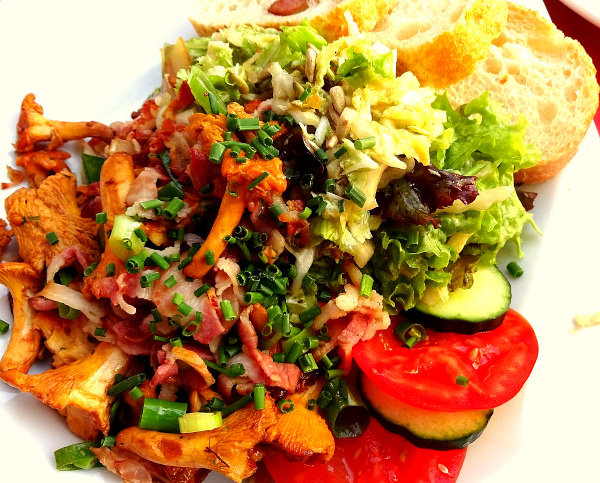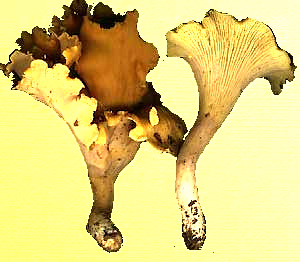 Mixed salad with fried, orange-colored Pfifferlings (Cantharellus cibarius), and bacon; Photographed in 'Bierhausla' in Kulmbach, Germany; image courtesy of 'Benreis' and Wikimedia Commons
Mixed salad with fried, orange-colored Pfifferlings (Cantharellus cibarius), and bacon; Photographed in 'Bierhausla' in Kulmbach, Germany; image courtesy of 'Benreis' and Wikimedia CommonsKINGDOM: Fungi
DIVISION: Basidiomycota
CLASS: Agaricomycetes
ORDER: Cantharellales
FAMILY: Cantharellaceae
Chanterelle is the common name of several delectable fungus species distributed in four genera. In general, they're orange, yellow or white, fleshy and more-or-less funnel shaped. Below, the one on the left is Craterellus odoratus, while at the right is a member of the "Cantharellus cibarius species complex," both picked in a woods in Mississippi.

Chanterelles can be prepared in many ways for eating, but maybe the favorite technique is simply to saute them in butter, oil or cream. Also they do well in recipes seasoned with wine or other cooking alcohols. Besides sauteed, they can be made into souffles, cream sauces, and soups. Normally they're not eaten raw, though there doesn't seem to be anything against it.
Chanterelles are also well-suited for drying, and tend to maintain their aroma and consistency well. Mixed salad with fried, orange-colored Pfifferlings (Cantharellus cibarius), and bacon; Photographed in 'Bierhausla' in Kulmbach, Germany; image courtesy of 'Benreis' and Wikimedia Commons
Mixed salad with fried, orange-colored Pfifferlings (Cantharellus cibarius), and bacon; Photographed in 'Bierhausla' in Kulmbach, Germany; image courtesy of 'Benreis' and Wikimedia CommonsMost members of the order Cantharellales are saprotrophic -- they derive their nutrients from dead organic matter, and thus help decompose plant remains. They can do this because they digest cell-wall cellulose or lignin.